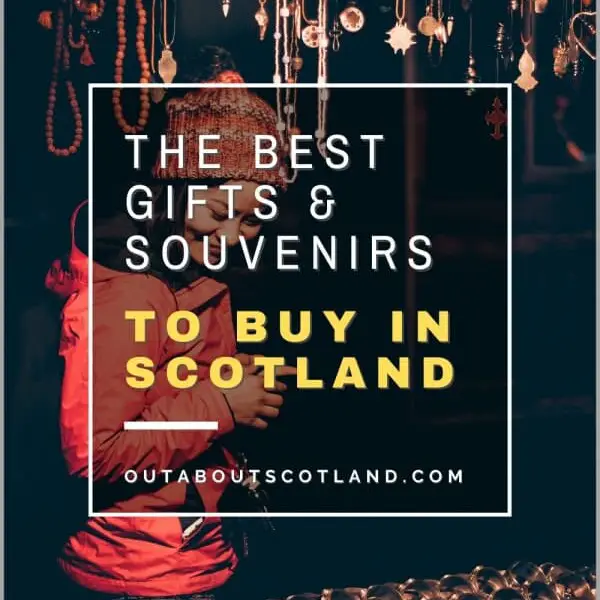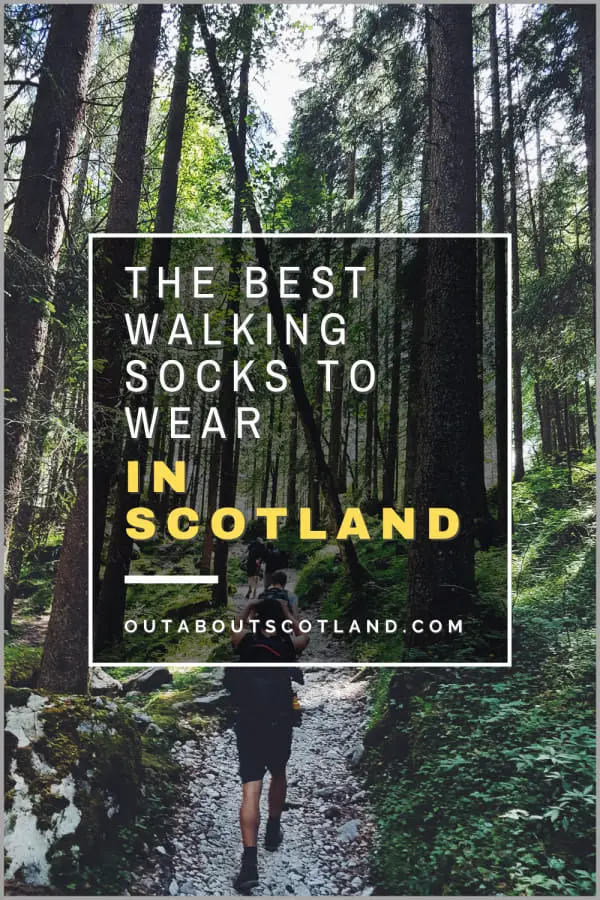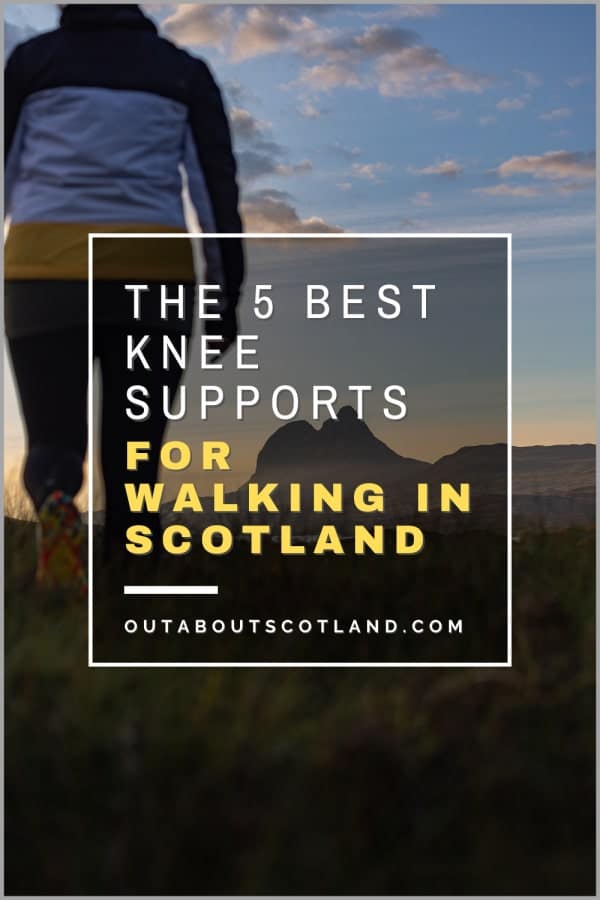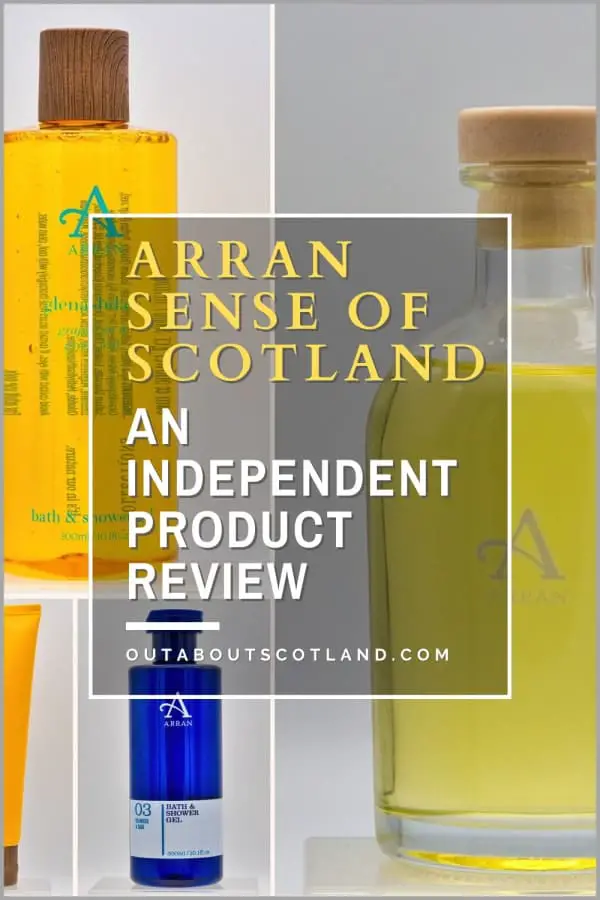Scotland is famous for its quality gifts and souvenirs, which include single malt whisky, cashmere clothing, crystal homeware, Heathergems jewellery, clan memorabilia, and Arran fragrances. Discover the best Scottish gifts and souvenirs to buy in Scotland in this information-packed guide.
Gifts for Women
Arran Sense of Scotland
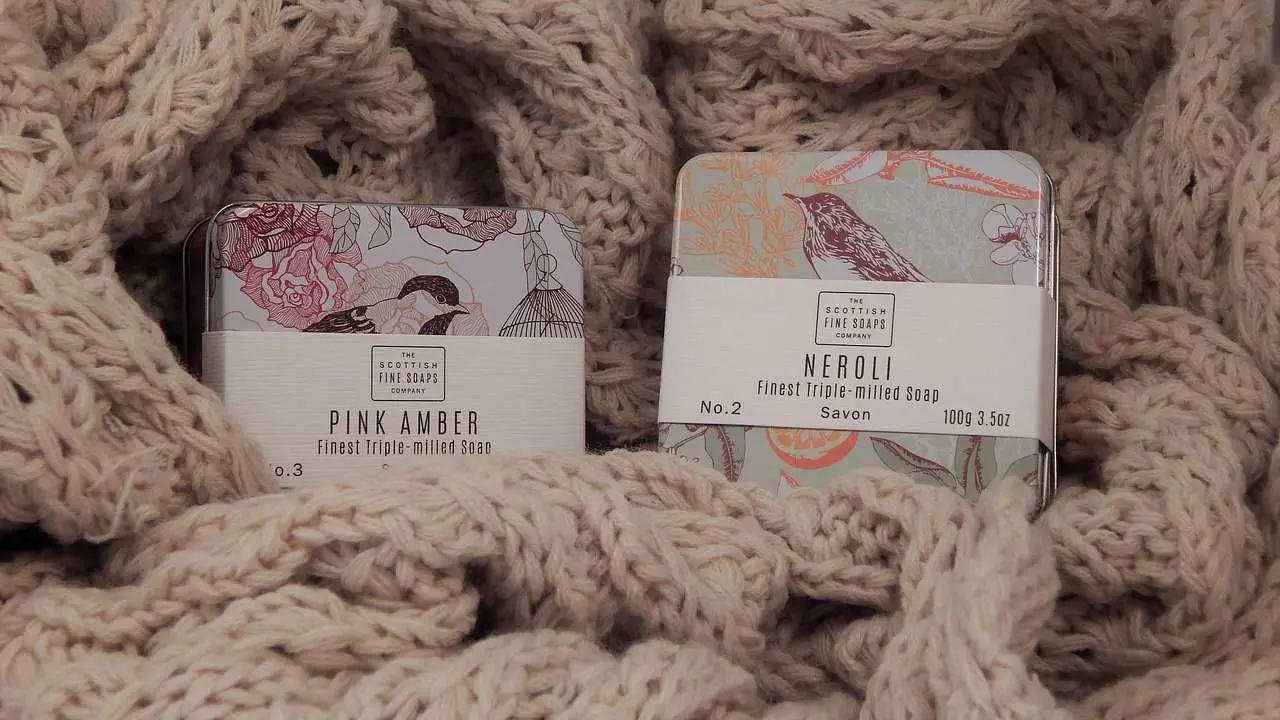
The first item on this list of Scottish gifts and souvenirs is my favourite by far. It’s also my other half’s favourite, my mum’s favourite, and just about the favourite of anyone who loves a good long soak in a bath with deliciously smelly, creamy suds. In fact, I rate this company so highly that I reviewed a bunch of their products and created an article about them, which you’ll find here: Arran Sense of Scotland Independent Product Review.
Arran Sense of Scotland is located in the heart of the Isle of Arran in a converted dairy farm between Brodick Castle and Brodick village.
I’d place them near the top of the luxury home smelly-things market (that’s an actual business category, isn’t it?) and they seem to expand their range with each new season, so they now include skincare, diffusers, candles, and men’s toiletries in their collection.
What I love about the products these guys make is their commitment to protecting the environment as all of their products are made from natural ingredients, are free from nasty chemicals, and are not tested on animals.
- The Glenashdale collection was inspired by the crisp waterfalls that bring a revitalising energy to the southern hills of the Scottish, Isle of Arran
- A truly invigorating fragrance with a zesty blend of freshly rasped lemons and grapefruit, finished with the clean, fresh crisp lift of bergamot
- The Glenashdale collection includes a traditional triple milled soap, luxury hand and body wash, moisturising lotion and cream
- Arran's products are extremely popular for both commercial and domestic applications, a natural choice for those that seek a luxury moment
- For three decades, arran has been creating vibrant, evocative scents, driven by their lifelong pursuit of exquisite scents with the power to seduce and captivate the imagination from their home farm factory, an old dairy farm for the historic brodick castle
- Please contact us if you have any unanswered questions about this product. We are happy to assist you with your enquiry
Arran Sense of Scotland is proud of its heritage, and each product line has a Scottish twist, so expect to find lots of hints of heather and gorse along with the Isle of Arran’s wildflowers – scents they’ve managed to perfect in the thirty years they’ve been going.
Arran Sense of Scotland started off as a family business that made luxury soap – which is still one of their most popular products – but my personal recommendation for a gift for men is the Lochranza Eau de Toilette which has a refined but not overpowering smell that lasts for ages.
My other half, meanwhile, swears by the After The Rain handwash. She won’t let me use much of it but when I’ve snuck a squirt out of the bottle while she’s not looking it always left my calloused hands feeling much smoother. Great stuff.
If you’re looking for an authentic Scottish gift bear Arran Sense of Scotland’s products in mind, and if you want to see what they currently have on offer check out the Arran Sense of Scotland website.
Cashmere Clothing

Cashmere is one of the world’s most valuable textile fabrics due to the fact that it’s so difficult to harvest. Unlike the wool from sheep, cashmere is woven from the fine, downy undercoats of one particular breed of goat, which isn’t actually native to Scotland.
These goats grow a thick, coarse layer of hair in the winter and only shed the fine hairs in summer, so not only is it slow-growing but there isn’t that much of it, meaning large herds are needed to produce enough fibres to make small amounts of textiles.
The number of herds in Scotland is growing year on year though, and today around 2,500 animals are used in the cashmere wool industry with the quality of the final product renowned the world over for its softness, durability, and warmth.
- Dry clean only
- 100% Pure Cashmere
- Measures 175 x 25mm
- Soft and Warm
- Comfortable
The inventiveness of Scotland’s clothes designers has taken cashmere wool to heart and there’s a fantastic range of hats, gloves, scarves, and coats that you can purchase online and on the high street. Expect a genuine Scottish cashmere wool jumper to cost in the region of £150 and scarves to cost around £40, so if you see a ‘cashmere’ item labelled in a gift shop for £10 or less you can pretty much guarantee it’s fake.
The material is well worth the money and if you look after it, it’ll last for years. I own a cashmere scarf that I’ve had for nearly ten years and it’s still going strong, and it has a bonus in that it seems to get softer and fluffier the more I wear it.
If you want an elegant, long-lasting quality Scottish gift, an item of clothing made from genuine Scottish cashmere wool is a great choice.
Heathergems Jewellery
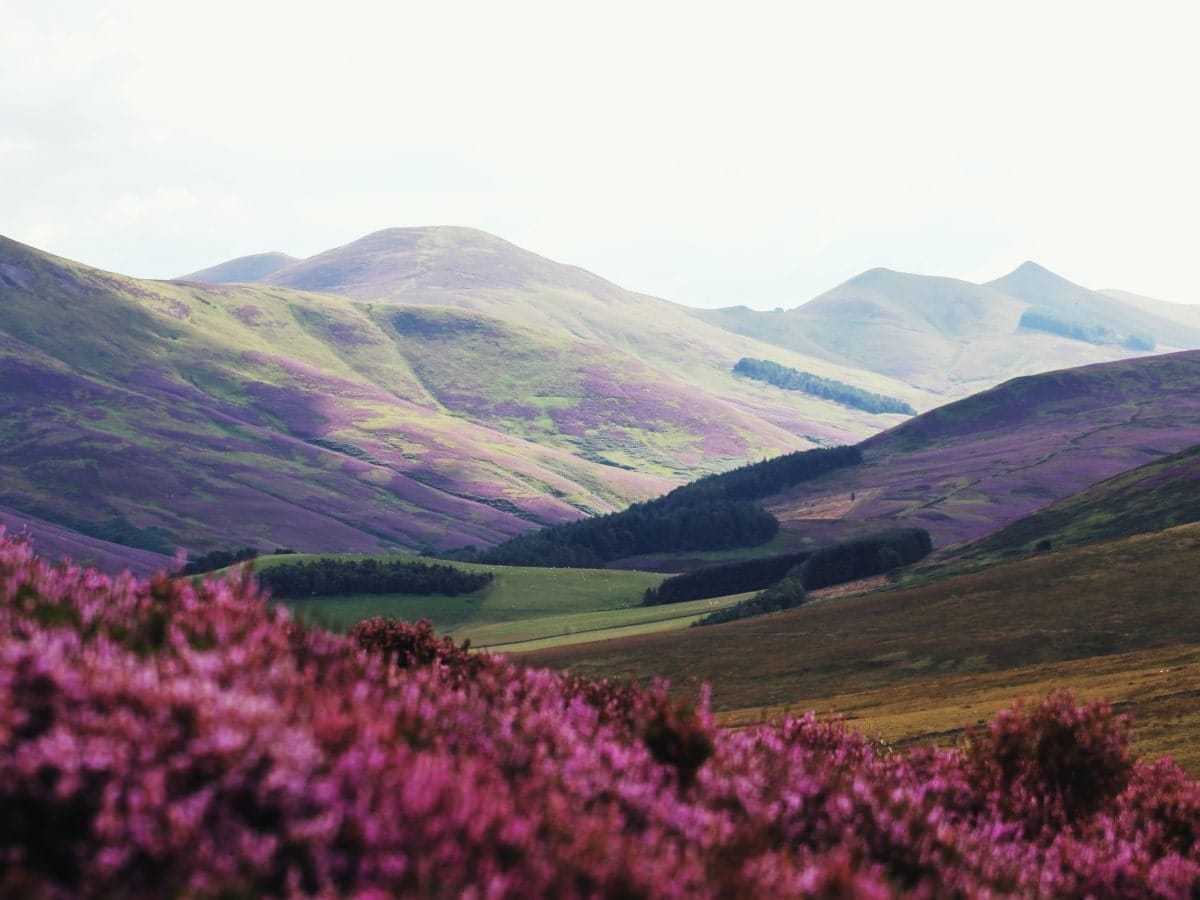
If you’ve visited the Highlands you’ll know that great swathes of the countryside are covered with the earthy colours of heather, the low-lying plant that gives Scottish mountains their brown colour in winter and their green and purple hues in summer.
Scottish heather is hardy and fast-growing and loves wet conditions, so as you can imagine it thrives all over this country. In fact, it grows across more than five million acres of Scotland’s moorlands, glens, and hills, so it’s no surprise it has several uses including medicine, beer, and jewellery.
The manufacturing process of Heathergems jewellery has been perfected over the last fifty years and it has become one of the most popular tourist souvenirs in Scotland, helped no end by the fact that each item is completely unique.
The heather is cut on hills in Perthshire, cleaned and bleached, and dyed in a variety of colours that reflect the ever-changing Scottish landscape. The heather stems are then soaked in resin and compressed, and the resulting multi-coloured blocks are fashioned into various shapes that are polished and set in mounts to create necklaces, bangles, brooches, earrings, and more.
There’s a visitor centre in Pitlochry where you can learn the process used to create these wee pieces of art as well as a shop where you can find some real bargains, but as it’s sold in jewellery shops throughout Scotland you shouldn’t have any problems finding the perfect Heathergems gift either online or in any Scottish city.
Scottish Tea
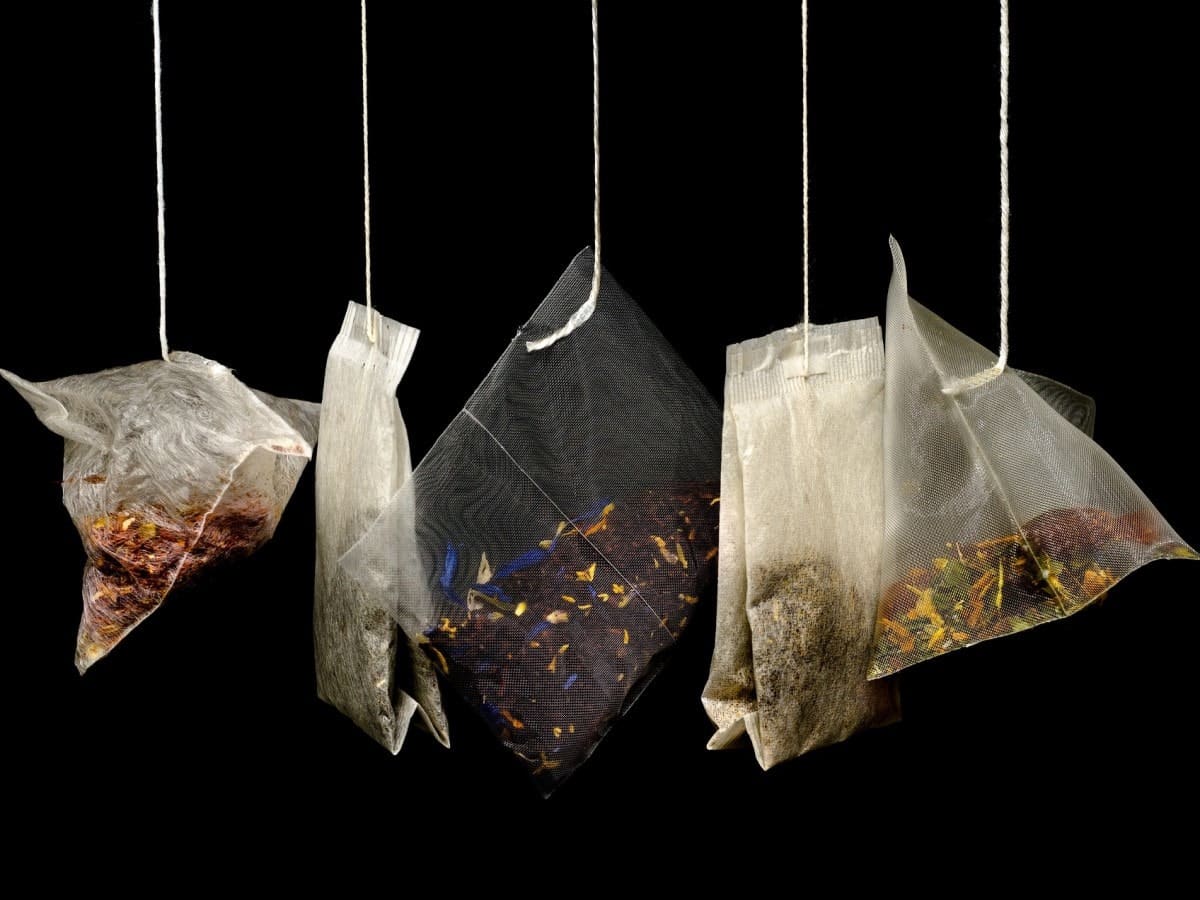
If you’re on holiday in the UK, you will at some point find yourself in the presence of tea. While coffee is fast becoming the nation’s favourite hot drink when out and about, the good old British cuppa is still incredibly popular at home, whether it’s drunk with a breakfast fry-up or with an afternoon snack.
There are actually three main types of tea in the UK – English, Irish, and Scottish – with the latter being the strongest, though even in the main categories there are further blends like English Yorkshire tea and Scottish breakfast tea (we take tea kind of seriously here in Britain…).
Scottish tea typically consists of black teas from Assam, India, and Africa, and was created to suit the soft water found in the country. The blend is known for its strong taste and dark colour, although there are subtler variations like Queen’s Breakfast tea which is lighter and easier to drink.
To make Scottish tea, the tea leaves are first harvested and then undergo a process called oxidation, where the leaves are exposed to the air till they darken and develop their distinct flavour. After oxidation, the leaves are dried, sorted, and blended.
As far as buying it goes, you’ll find Scottish tea in most supermarkets and online retailers like Amazon, but for quality tea in nice packaging, you’re best off heading to speciality tea shops like Rosevar Tea in Edinburgh or Whittard which has stores in Edinburgh and Glasgow.
Other popular brands of Scottish tea include Brodies, Edinburgh Tea & Coffee Company, and Taylors of Harrogate, each of which is usually stocked in souvenir shops in decorative metal tins that are ideal for transporting in luggage bags.
Gifts for Friends
Something Tartan
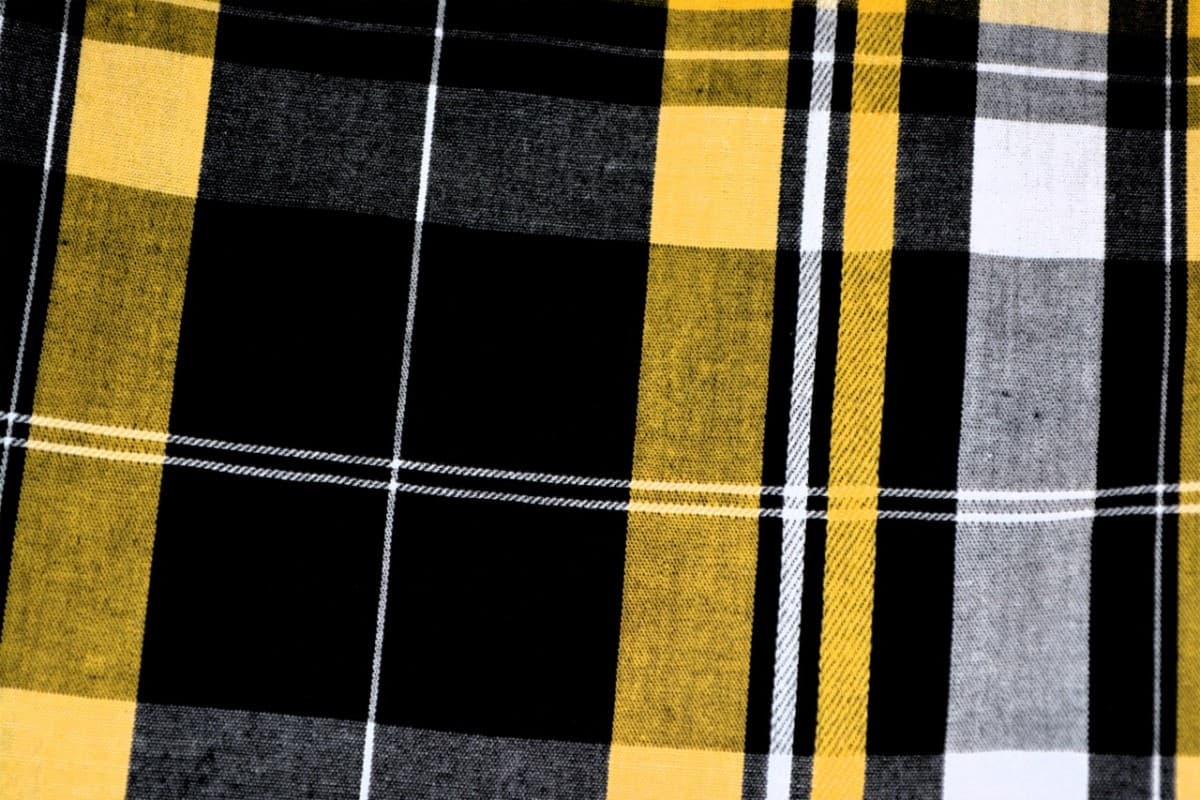
Tartan is a type of chequered cloth that features a design with crisscrossed lines of multiple colours. Even though nowadays tartans are connected with specific clans, they originated from the simple fact that weavers in different regions each had their own unique approach to making cloth.
The first tartans were made with a basic check pattern and employed natural light and dark wool, but the tartans we’re familiar with today developed in the 17th century when clans associated themselves with the style of cloth made in their region of Scotland.
While the design can be used in many ways it’s most often associated with the kilt which is a traditional knee-length item of clothing for men that originated in the Highlands but is now worn throughout Scotland at formal occasions like weddings.
The days of tartan only being used in kilts is long-gone though, and today you’ll find it on a wide range of items from umbrellas to scarves and blankets to biscuit tins. Because it’s such a timeless design it never goes out of fashion, and because tartan is well-loved by all ages from teenagers to pensioners it’s perfect for gifts and souvenirs.
Options for tartan clothing are endless, but if pushed for a favourite, I’d have to recommend a tartan scarf, as they’re unisex, lightweight, look good, and are made from a range of materials that will suit all budgets. Cheap tartan scarves tend to be made from polyester, which is hard-wearing and easy to clean, while premium designs use wool or, preferably, cashmere, which feels incredibly soft but is usually dry-clean only.
There are a handful of tartan manufacturers in pretty much every souvenir shop in Scotland – Royal Mile Collection, Glen Isla, Locharron of Scotland, Heritage of Scotland, and Dunedin – which are virtually identical in quality, so my advice would be to just make sure the item of tartan cloth has a ‘made in Scotland’ label and buy whichever one you like the most.
Clan Memorabilia
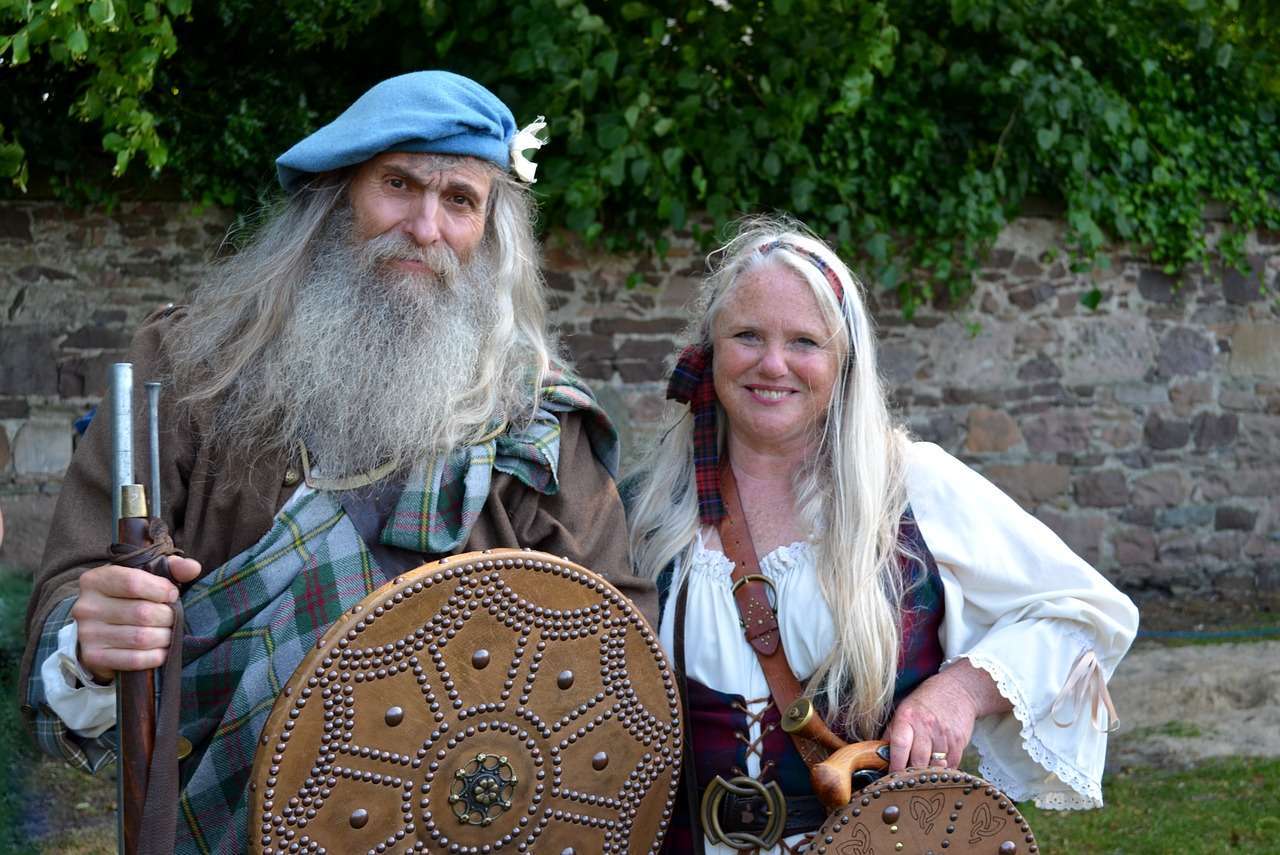
The Scottish are a proud nation, and they’re just as proud of their ancestral heritage as they are of the country they live in, which is perhaps the reason why an entire industry has spawned around the clans.
The Scottish warlords who established the clans in the 12th and 13th centuries did so by enforcing their rule over the local peasants by promising them protection in exchange for money (protection rackets have been around for a very long time). However, they weren’t officially sanctioned until the 14th century, when Robert the Bruce granted them land in exchange for going to war against the English.
The clan structure died away after the failed Jacobite rebellion of 1745 but the names live on and today the ancestors of the original clans enjoy a shared sense of history and belonging thanks to the distinct tartan colours and crests that each clan lays claim to.
The majority of clan souvenirs can be found online but you’ll also find gift shops dedicated to specific groups when you visit certain historic tourist attractions like Duart Castle (Clan MacLean) on the Isle of Mull and Castle Campbell (Clan Campbell) near Stirling.
If you’re looking for a clan souvenir, you’re spoilt for choice, as there are over 3,500 different tartans to choose from and over 500 separate clans with their own crests. The biggest, Mackenzie, MacDougall, MacLeod, etc., have lots of memorabilia in most of Scotland’s tourist shops, and you’ll be able to get pretty much anything you can imagine labelled or engraved with your clan’s name and crest.
Most people like to buy gifts that feature their clan’s tartan, and you’ll be amazed at what you can find once you start looking, but if you really want to get an authentic memento that’ll last for years, you could always get a kilt. Kilts are still worn at all Scottish formal gatherings, so if you’ve got a few upcoming weddings in Scotland, it might be something worth investing in, but be warned, a top-quality one can cost well more than £500.
If you’re in Scotland you’ll find authentic kilt-makers in most high streets and many of them have ex-hire kilts that are a fraction of the cost of buying a brand-new one.
Edinburgh Crystal
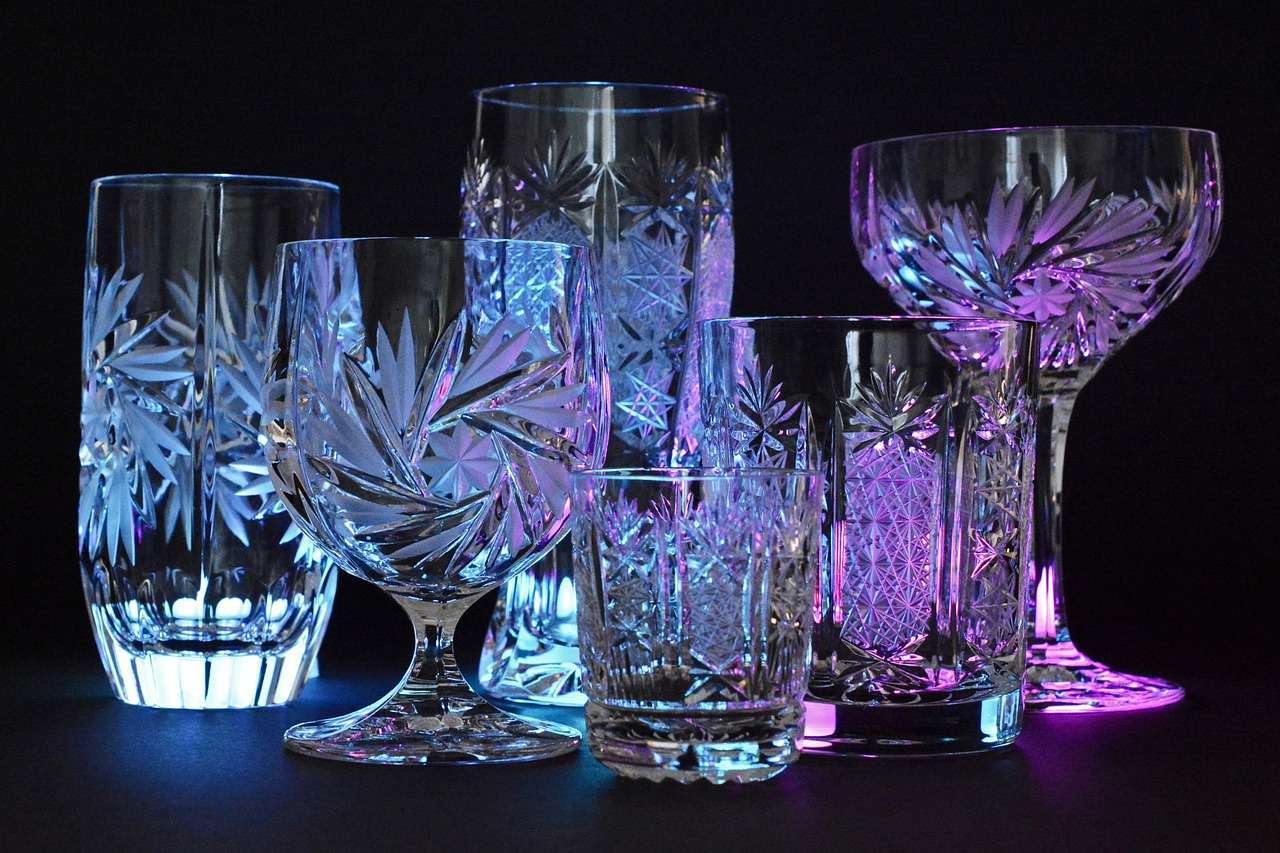
Unlike the other gift ideas in this article, Edinburgh Crystal is a product that’s no longer made, but it’s still possible to find decent examples if you like browsing second-hand shops, especially in Edinburgh.
The Edinburgh Crystal Company sadly closed its doors in 2006 after a 139-year run, but the legend of the quality cut glass they manufactured lives on to this day, as can be seen in the number of crystal tableware, decanters, and vases that are sold on eBay.
The majority of the pieces you’ll find sold in antique shops are wine glasses, whisky decanters, fruit bowls and candlesticks, which aren’t that much more expensive than the items produced by ongoing British glass manufacturers like Waterford, but Edinburgh Crystal is considered to be more prestigious.
It’s also very heavy, so bear that in mind if you have airline weight restrictions on your return journey, and you’ll need to make sure it’s well packaged for when the baggage handlers inevitably decide to play football with your cases.
There are loads of designs in the Edinburgh Crystal portfolio, but four are considered to be collector pieces (Star of Edinburgh, Thistle, King James, and Lochnagar), so if you’re lucky enough to find boxed examples with those names, be quick and snap them up. Unless you look on eBay, it’s unlikely you’ll find genuine Edinburgh Crystal glassware online, but Royal Scot Crystal sells similar designs on Amazon.
Haggis
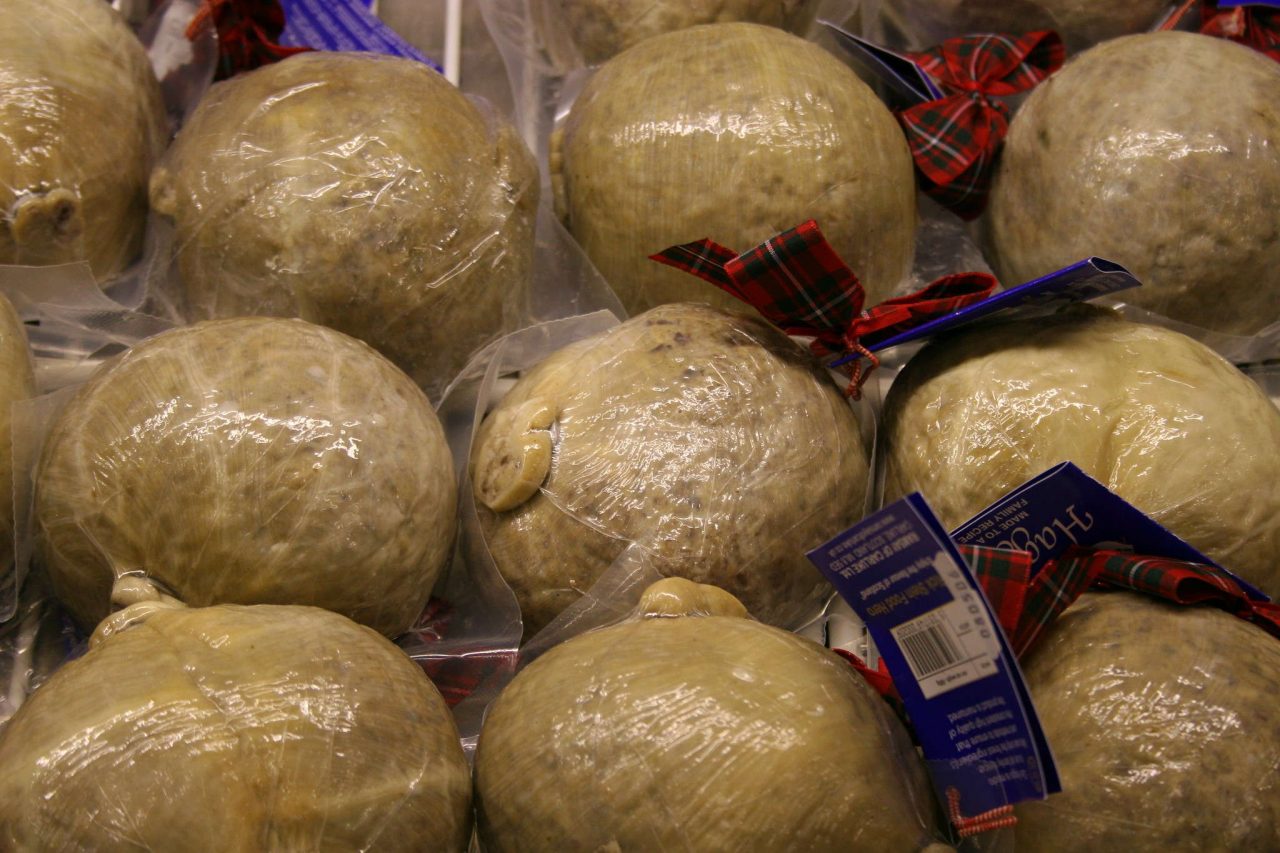
I have to admit my mouth is watering as I write this because I love haggis. If you’re from overseas and have never heard of haggis, it’s a savoury pudding that has been part of the Scottish diet since the 1400s. Traditionally served with neeps and tatties (mashed Swedish, turnips, and potatoes), haggis comes in various shapes and sizes but is usually bought in 500-gramme ball or sausage-shaped portions, which are enough to serve 2–3 people.
It has a rough and crumbly texture and a peppery taste that works remarkably well with a good helping of whisky sauce, but it’s also versatile enough to be served fried with chips or even served on pizzas. You can even get vegetarian haggis, if that’s your thing.
- A 'whole' Vegetarian Haggis in a tin - drained weight 232g
- Made in Scotland from Oatmeal, Vegetables, Kidney Beans and Lentils
- Suitable for Vegetarians and Vegans
- Minimum 2 year shelf life
- No refrigeration required prior to opening
- Hob: Remove from can. Place in a pan of hot water. Simmer for 35 minutes. DO NOT BOIL. Microwave: (800 watts) Remove from can and remove skin. Break up the haggis and place in a microwaveable dish. Cover and heat for approx 4 minutes, stirring occasionally. Oven: Remove from can. Wrap haggis in foil and heat in oven for 30 minutes at Gas Mark 4 or 180 degrees C. Heating may cause pressure to build up beneath the skin. CARE MUST BE TAKEN WHEN PIERCING SKIN OF THE HAGGIS. It is adviseable to cover the haggis with a clean cloth when piercing the skin. Synthetic skin is not edible. Always ensure haggis is piping hot prior to serving. Traditionally served with mashed potatoes and turnip.
- Synthetic skin is not edible. Care should be taken when opening can and when piercing skin
Now for the unpleasant bit – the ingredients. I’m afraid the things that go into haggis are enough to give most people nightmares and to be honest when you see one in the flesh they look pretty gross.
The origins of Scotland’s national dish evolved from hunters who needed a way to store the offal of the animals they killed, as the internal organs tend to go off before the rest of the meat. So what those ingenious Scots did was remove the heart, liver, and lungs, mash it all up and mix it with onion, oats, and spices, and encase the resulting stodge in the animal’s stomach lining.
I told you it was gross.
The taste, however, is amazing, and once you start tucking in it doesn’t take long to get over the thought of what you’re actually eating. It’s really easy to cook as well because all you need to do is either boil it or pop it in the microwave.
As far as brands go, Macsween is one of the best but Grants aren’t far behind, and you’ll find gift-packaged versions from both manufacturers throughout Scotland.
Harris Tweed
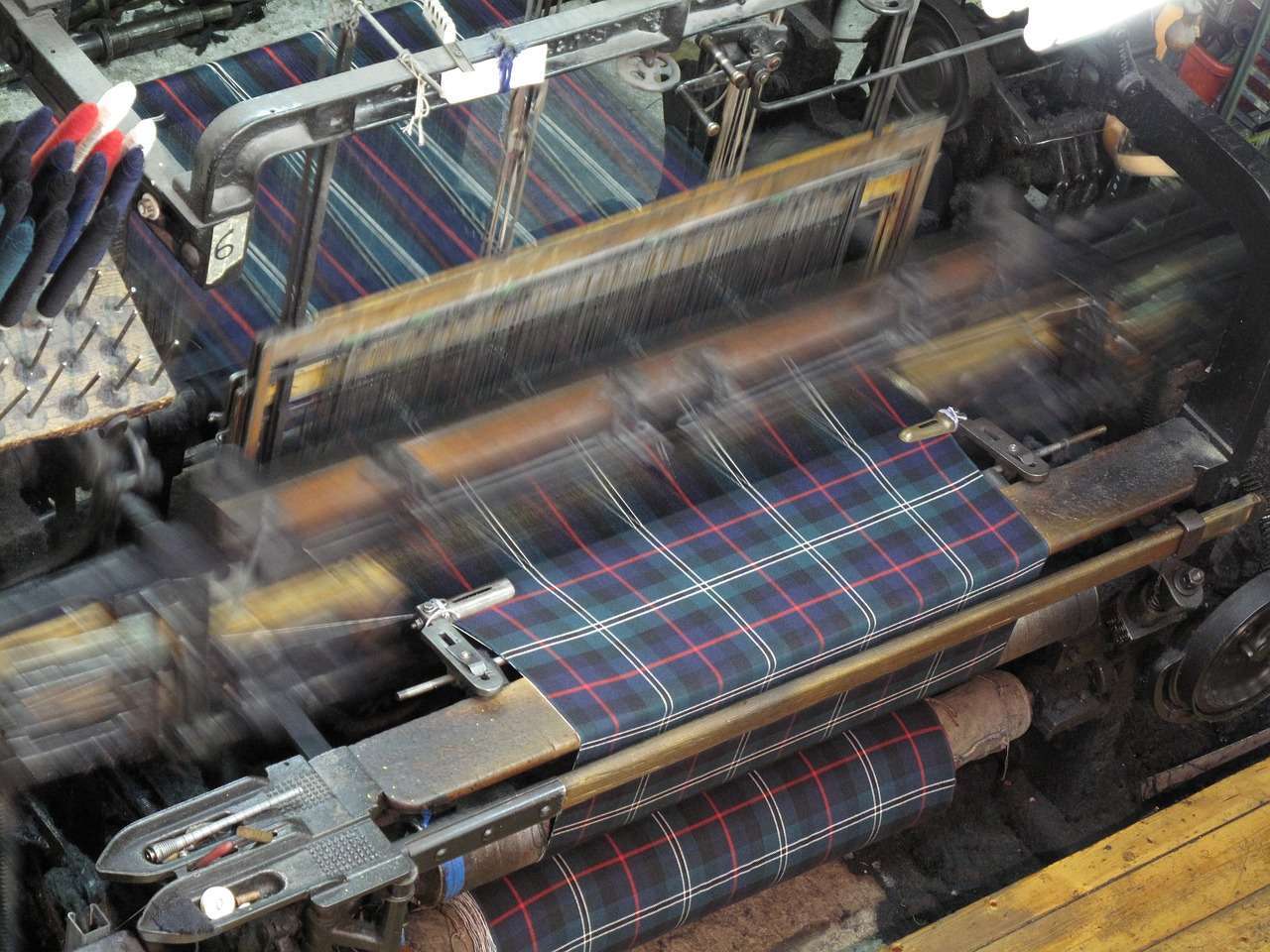
Harris Tweed is one of the oldest commercial products made in Scotland today, with a heritage that goes back nearly 200 years. This cloth is sold around the world and is easily recognised by the Harris Tweed logo, which features an orb and cross – officially Britain’s oldest certification mark.
There are a huge number of products made from this material, and several manufacturers use it in their clothing lines However, the Harris Tweed brand is closely guarded, and the fabric is only allowed to be made on the Isle of Harris in Scotland’s Outer Hebrides.
To get the certification, 100% pure wool must be sourced from Scotland and washed, dyed, and spun on human-powered looms just as it was in the 1800s, with the final cloths undergoing a rigorous inspection. It’s for these reasons that Harris Tweed has gained a reputation worldwide for its strength, durability, and longevity.
By law, the certification tag has to be stitched onto every item that uses the fabric which is why you’ll see smaller gifts like whisky flasks and phone cases displaying it proudly front and centre, and in fact these labels have gained as much of a cult following as the material itself has.
You’ll find products made from Harris Tweed in pretty much every major tourist attraction in Scotland and there’s an incredibly wide range to choose from. Everything from coats to handbags to shoes and hats is made from the cloth, which makes it a great gift to give or keep for yourself as a souvenir.
If you’re looking for something made from Harris Tweed and you’re in Edinburgh or Glasgow, you’ll find a multitude of items in any of the main shopping centres, or you can shop online and browse Amazon, where you’ll find a selection of the most popular items.
Quaich
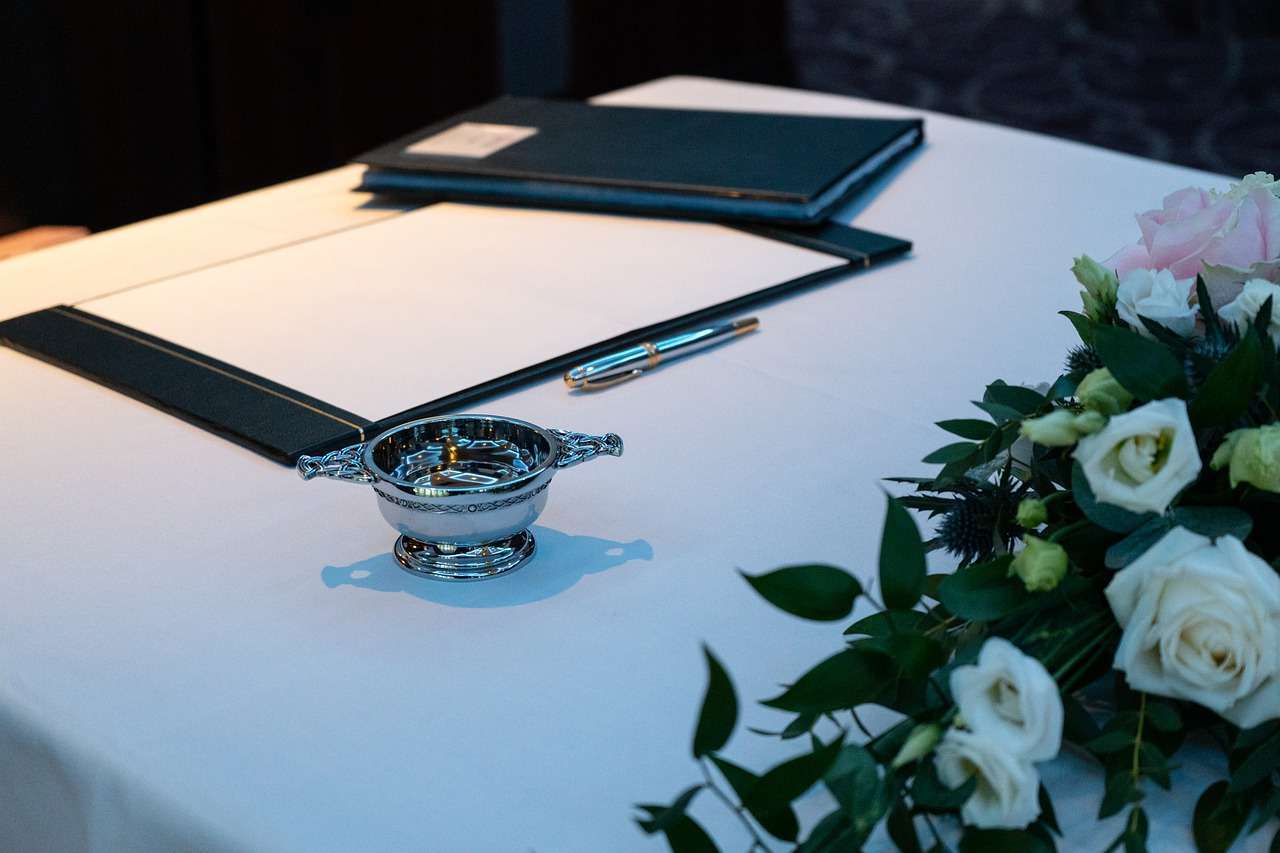
A quaich (pronounced quake, as in earth-quake, but with the hard ‘k’ replaced by the Scottish ‘ch’ sound made from the back of the throat), is a traditional Scottish cup with a low bowl and two handles that was historically used as a way for quarrelling gentlemen to put aside their differences before evolving into its modern-day use as a symbol of friendship.
The idea when using a quaich is to pour whisky into it, take a drink holding the two handles, and then pass it over to the other person, which is perhaps the reason why it’s nowadays often used in Scottish marriage ceremonies where the bride and groom each take a sip before saying their vows.
While the earliest versions of the quaich were made from wood, today’s modern interpretations use a variety of materials, including pewter, silver, horn, stone, and brass. They’re also usually engraved with Celtic-style markings, so they look quite ornate, which means they make a beautiful gift or a keepsake.
You’ll find quaichs in most jewellers as they’re frequently engraved and handed out on special occasions like birthdays, and they come in a range of sizes from plain 6-inch pewter ones costing £30-£40 to hallmarked solid silver examples coming in at nearly £1,000.
You might like to get your own quaich engraved while you’re in Scotland with a clan or family name but if not you’ll find a wide selection with generic designs on Amazon.
Gifts for Men
Sgian Dubh
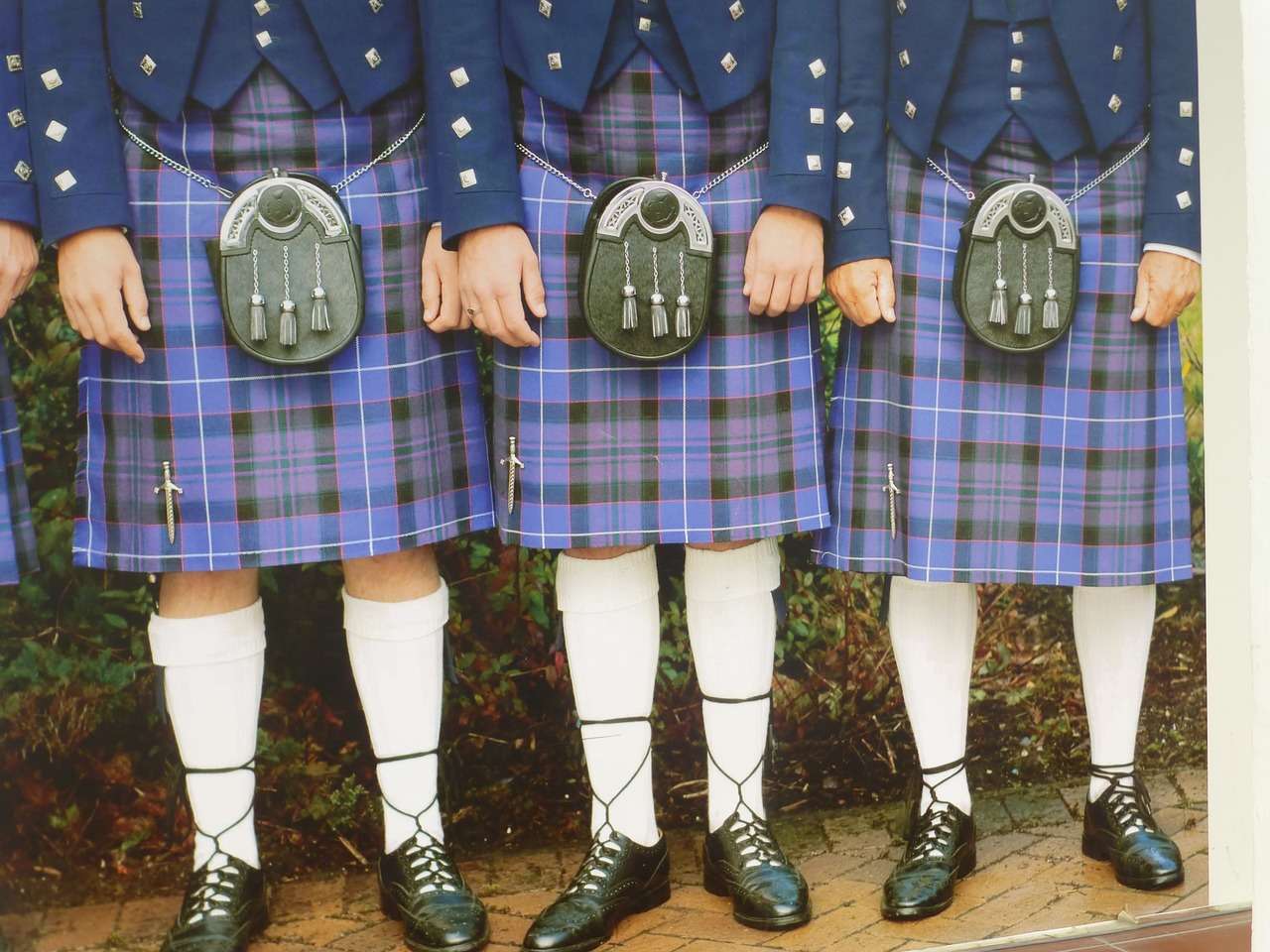
A Sgian Dubh (pronounced ski-an doo) is a small, single-edged knife that’s worn as part of a traditional kilt. Featuring an ornate hilt and a plain scabbard, the Sgian Dubh is normally kept in the band of the sock on the right leg, where it’s held in place by a small garter.
Although the origins of this now-ornamental knife stretch back hundreds of years it’s still used in traditional Highland dress and you’ll see them at all sorts of modern-day occasions including weddings, balls, and gatherings like Burns Night.
The reason why these knives are part of the traditional Highland dress is that they used to be kept under the armpit and were only drawn if the person came under attack, but as so many people had one back in those days, it was considered polite to keep them in plain sight when entering someone’s house, hence their move to the sock band.
You’ll almost always find them in Scotland’s jewellers which is one of the best places to purchase them as the handles will often be made from antler bone or metal which looks much nicer than the cheap plastic ones you usually see in tourist gift shops.
Although the blade of these knives is only around 6 inches long the handle is often longer so you’ll likely need to check it in if you’re travelling through one of Scotland’s airports as it could very well exceed what is allowed onboard.
Note that although their use as part of a kilt is allowed in Scotland, the tip is pointed and there’s a serrated edge on one side, so a Sgian Dubh could quite easily be classified as an offensive weapon in many countries. You might get away with a replica, though, and nowadays many Sgian Dubh’s have plastic blades that are designed to be kept in their scabbard, and some purely ornamental Sgian Dubh’s have no blade at all.
Note that these knives are really just for decoration so if you’re hoping to get one and take it into the great outdoors you’ll be better off getting any bog-standard multi-purpose knife instead.
Scotch Whisky
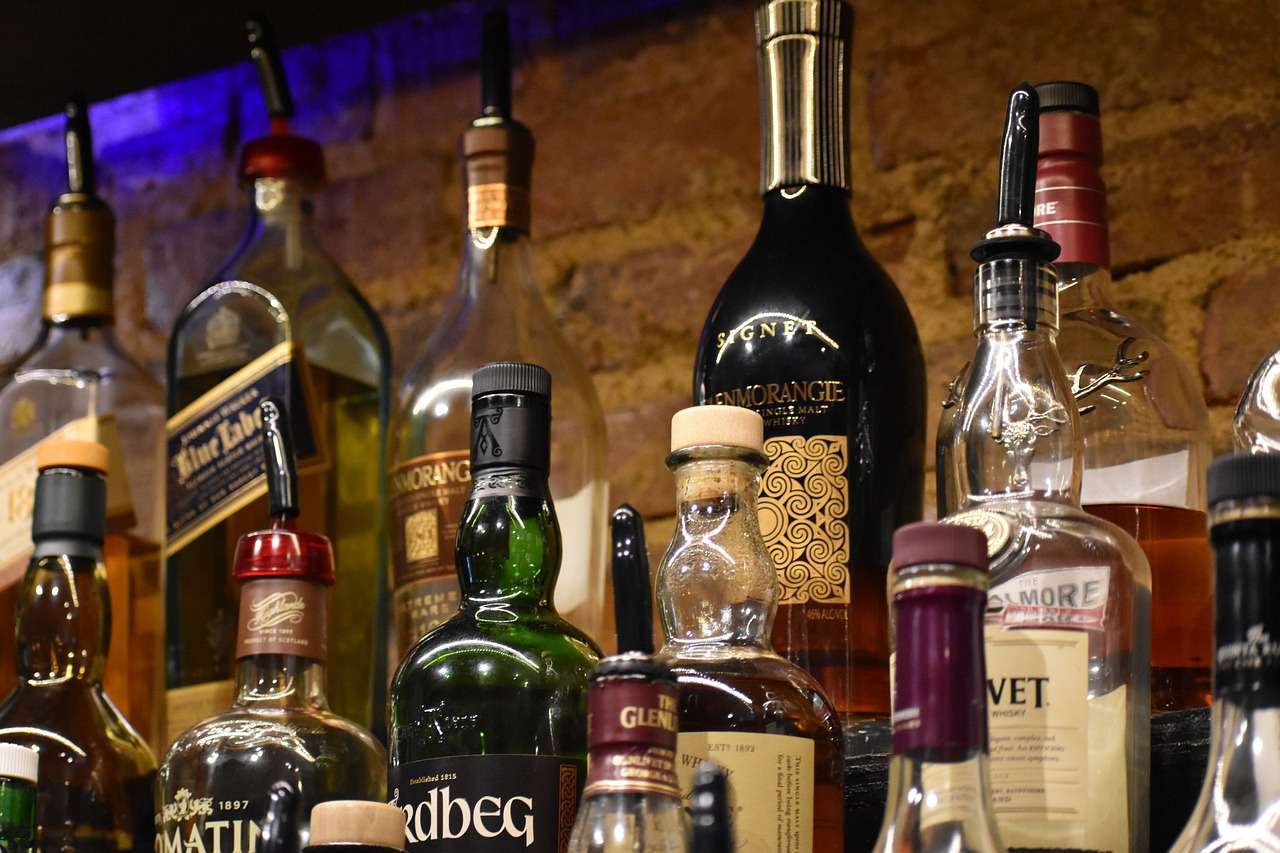
This gift idea is probably the one that first comes to mind when thinking of a souvenir that sums up Scotland – Scotch whisky.
Scotch is one of this country’s biggest exports and it’s drunk all over the world, with collectors willing to spend thousands on rare bottles. While there have been many imitators over the years, none have come close to the genuine article, which is why a quality bottle of single-malt is such an iconic thing to buy on a visit to Scotland.
There are five main whisky-distilling areas in Scotland, each of which has its own distinct flavour, but the two most popular are the Speyside and Islay whisky regions. Speyside is the area of the Highlands towards the east of the country around the River Spey, while Islay whisky comes from… the Isle of Islay. No surprises there.
- This is an essential guide for single malt lovers.
- Must read book
- It ensures you get the best usage for a longer period
Speyside whisky tends to produce sweet, floral flavours that are quite delicate and in total contrast to the spirit produced on Islay which is generally very peaty, smoky and in some cases, medicinal.
There are more books, video tutorials, and accompanying drinkware than you’ll be able to fit in your holiday bag, so what I suggest you do is either get a few 5cl miniatures from each region of Scotland you visit or get one (make that two) big 70cl bottles of your favourite tipple.
If you’re not sure what to buy pop into any dedicated whisky shop and ask the staff for help, but don’t go expecting free samples as that’s generally left to the distilleries to dish out. Whisky shops almost always have whisky experts on hand and they’ll be able to suggest a few options you might like, but if you already have a big-name brand in mind you’ll typically find the best prices in supermarkets like Tesco and Sainsbury’s.
Scottish Gin
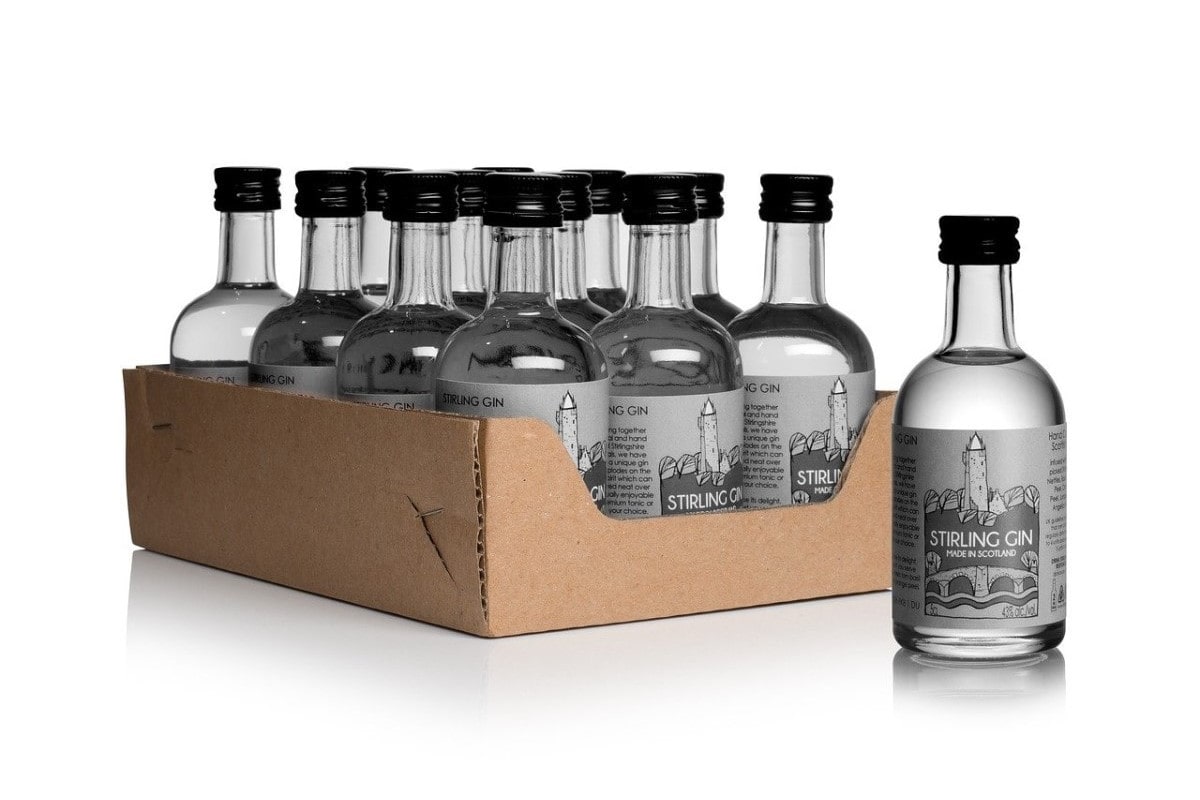
While Scottish gin might not be as big of an export as Scotch whisky (at least not yet) its popularity is exploding and in the last decade the artisanal gins produced in Scotland have gained a cult following. Traditionally, gin is seen as an English spirit, and dry London gin is one of the world’s favourite varieties. However, the fact is that of all the gin produced in the UK, more than 70% of it comes from Scotland.
So why is that? Well, it started in Edinburgh’s port of Leith in the 1700s. Back then, Dutch traders sailed in and out of Leith regularly, carrying with them an exotic range of spices as well as the fiery Dutch spirit of Jenever. The combination of this spirit and the rich abundance of herbs and spices led to the blending of an alcoholic drink that slowly transitioned into the style of gin that is enjoyed around the world today.
Three of the world’s best-selling gins – Gordon’s, Tanqueray, and Hendrick’s – are now made in Scotland, and some of the world’s oldest gin distilleries are still producing spirits, including Eden Mill in St. Andrews, which is over 200 years old. It’s fair to say, then, that Scotland is at the heart of the gin distilling industry.
When it comes to gin-themed gifts and souvenirs, you’ll find a number of differences compared to whisky. The first and most obvious is the fact that bottles of top-end gin are generally much cheaper than top-end Scotch, and while you could potentially pay over £1,000 for a bottle of ‘the water of life’, the best gins tend to come in at around fifty quid.
The bottles are also much more attractive than whisky bottles and have a wider array of designs, with everything from coloured glass featuring embossed motifs to ceramic bottles with wooden stoppers.
Gin bottles don’t have quite the same mythology as Scotch whisky bottles, but the rarer ones are starting to sell for ridiculous amounts on eBay, so if you purchase an unusual bottle for yourself you might consider keeping it for the future to see if the value skyrockets one day.
As far as distilleries go, you won’t go wrong with Edinburgh Gin, while the island gins of Islay (The Botanist) and Skye (Misty Isle) come highly recommended too.
As far as buying gin goes, you’re pretty much spoilt for choice, as most whisky shops sell it, as do supermarkets, off-licences, airports, and some of the better tourist gift shops. Personally, I suggest ordering a bottle from Amazon as you won’t have to worry about transporting the delicate glass bottle back home, unless you really want the authentic touch, in which case just head to any gin distillery during your travels as they all have their own outlets.
Scottish Sweets
Here in Scotland, we’ve perfected the art of making delicious treats that aren’t particularly healthy but are guaranteed to bring a smile to anyone’s face, whether they’re 8 or 80. Traditional Scottish cooking is decidedly different from the English style because it developed independently and made use of different ingredients.
Up until the early 1500s, Scotland lacked a distinctive cooking style while the English refined Roman-imported cooking techniques. It wasn’t until the time of Mary, Queen of Scots, that the inklings of traditional Scottish cooking appeared, thanks to the influence of the French, whom Mary allied with.
One of the earliest sweet treats in Scotland was a traditional biscuit bread that was made from leftover bread dough. The dough was mixed with butter and allowed to dry out, which resulted in something similar to a crumbly rusk, which, as you’ve probably guessed by now, developed into shortbread.
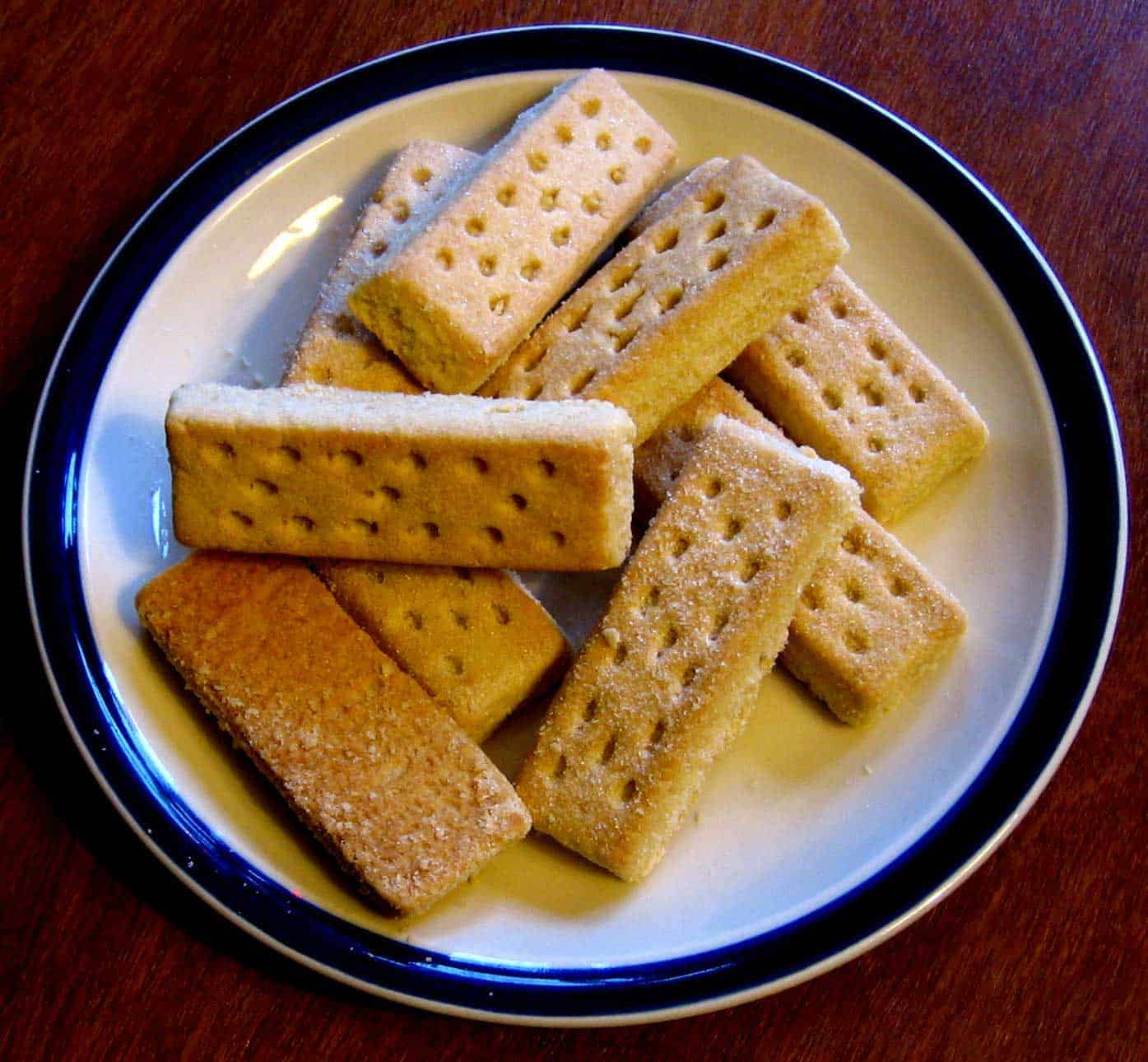
Today, shortbread is one of the most-exported Scottish food products after whisky, and the sight of a tin adorned with a piece of tartan and an obligatory Highland cow can be seen in every single tourist gift shop in the country.
There are dozens of manufacturers of these delicious biscuits, but by far the most famous is Walker’s, who are so respected that even he royals loves their products and have granted them a warrant to supply the royal household. Alternatively, Dean’s of Scotland and Stewart’s of Scotland make superb shortbread, though having tried both, I’d give the nod to Dean’s for taste and Stewart’s for presentation.
Another famous Scottish treat is Tunnock’s teacakes which are a bit of a legend in their own right. Tunnock’s have been making lip-smacking treats in Scotland since the 1890s, but it’s their iconic teacakes that the nation has taken to heart.
- Tunnock's Milk Chocolate Teacakes (6 per pack - 144g)
- Pack of 2
- Please be aware that unless expressly indicated otherwise, Cooking Marvellous are not the the manufacturer of this product. Product packaging may vary from what is shown on this listing. We recommend that you do not rely solely on the information presented on our listing. Please always read the labels, warning and directions provided before using or consuming the product.
They comprise a biscuit base with a thick layer of marshmallow on top, all covered in a yummy coating of chocolate. They’re not exactly healthy and the sugar content alone is enough to make dentists weep, but paired with a good-old Scottish cup of tea they’re bliss in a foil wrapper.
Tunnock’s tea cakes can be found in pretty much any Scottish supermarket, and to be honest, that’s exactly where I recommend getting them from, as the gift packs in tourist shops are seriously overpriced. While hunting around on the shelves, keep your eyes open for Tunnock’s other delicious snack, caramelars,which are layers of wafer separated by caramel and covered once again in thick chocolate.
Other Scottish sweets are butterscotch (hard sweets made from sugar, cream, and butter) and tablet (a type of fudge that’s harder and has a crumbly texture), as well as clootie dumpling (a type of dried fruit pudding).
Frequently Asked Questions
What are popular souvenirs to buy in Scotland?
Clothes made from Scottish cashmere wool. Clan memorabilia featuring clan mottos and crests. Edinburgh Crystal and Royal Scot Crystal glassware. Haggis. Clothes and products made from Harris Tweed. Heathergems jewellery. Quaich (a traditional Scottish drinking bowl). Sgian Dubh (a traditional ceremonial knife). Single-malt Scotch whisky.
Where can I buy Scottish gifts?
Tourist shops in towns and cities. Tourist information centres. Airport shops in Scotland. Tourist attraction shops, e.g. Edinburgh Castle. Manufacturer retail outlets, e.g., the Harris Tweed Company on the Isle of Harris. Online retailers, e.g., Amazon.
What is Harris Tweed?
Harris Tweed is a cloth made from 100% goat wool that is sourced from Scotland and washed, dyed, and spun on human-powered looms. Only the Harris Tweed Company is allowed to certify the material with the 200-year-old Harris Tweed logo.
What types of Scotch whisky can I buy?
There are six main whisky-distilling regions in Scotland, each of which has its own distinct flavour, but the two most popular are Speyside and Islay.
Other regions of single-malt whisky are Campbeltown, the Highlands, the Lowlands, and the Scottish Islands.

